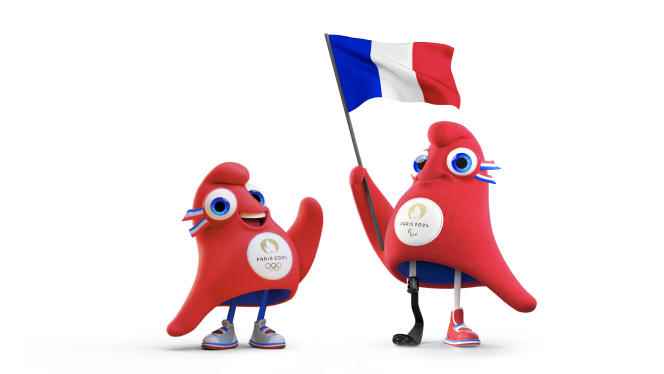She wears a big red dress, a frank smile, a tricolor cockade at the end of her big blue eyes. She answers, or rather they answer, in the name of Phryges, since there are two of them. The Phryges are the mascots of the Paris 2024 Olympic and Paralympic Games, unveiled on Monday November 14 by the Games Organizing Committee (Cojop).
As their name suggests, they are inspired by the Phrygian cap, symbol par excellence of the French Revolution and Republic, taught in all classrooms. “We were looking for a mascot who embodies the French spirit, who wears the colors of the country, a part of our history”explains Julie Matikhine, the brand director at Paris 2024, who specifies that the choice of the mascot has been tested and validated by samples of children aged 6 to 14.
Les Phryges – a difficult name to pronounce and write, even more so for a foreigner – are quasi-twins, or twins, since the Paris 2024 mascot is gender neutral. Their differences? One has a prosthesis and a red trainer while the other is wearing two white trainers with tricolor laces. Olympic Phryge, who knows why, is portrayed as the more thoughtful brainy of the two, while her Paralympic alter ego is portrayed as party girl and hothead.
For the rest, gossips say that Phryge looks like a hen. To review the precedents in the history of the olympicsthe Phryges are far from the least successful mascots.
A lucrative business
Should we see in the choice made by Paris 2024 of the Phrygian cap, three years after a common logo for the Olympic and Paralympic editions – for the first time in the history of the Games – another manifestation of Cojop’s desire to break with previous Olympics? A way of “breaking the codes”a formula dear to Tony Estanguet – head of the Cojop –, “to help the French to make their revolution through sport”according to Julie Matikhine?
The organizers of Paris 2024 have in any case ruled out the choice of an animal. Because since “Schuss”, the first mascot in the history of the Games, in Grenoble in 1968, two thirds have been embodied by animals, the majority of which are bears, a reference to the Teddy Bear of our childhoods.
Co-designed by the creative agency W and by the Paris 2024 design teams, the Phryges will be available from November 15 on Carrefour shelves, a “premium” partner of Paris 2024 and exclusive distributor in supermarkets, in the main toy stores. (Joué Club, La Grande Récré, etc.), as well as in the first official physical store of Paris 2024, which is due to open on November 14 at Les Halles, in Paris.
Made in China by French SMEs Gipsy Toys and Doudou and company – which is taking the opportunity to relocate 15% of its production of plush toys to its factory in Brittany –, the Phryges – made up mainly of recycled materials – will also be available in the form of T-shirts, hoodies, key rings and even of pins.
The Cojop aims to sell two million copies of Les Phryges until the Olympic Games. At 26 euros for the 24 cm model (several sizes will be available, up to 80 cm), the sale of mascots represents a juicy market. All the more so when we remember the Bing Dwen Dwen madness at the Winter Games in Beijing in February, during which uninterrupted lines of customers thronged to the points of sale to leave with the plastic panda that had become too rare. Sales of Phryges branded products could represent up to 25% of Paris 2024 “licensing” revenues, estimated in total at 127 million euros. Revolutionary the mascot, but above all a very good deal.
